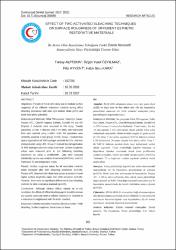| dc.contributor.author | Alptekin, Tuncay | |
| dc.contributor.author | Özyılmaz, Özgün Yusuf | |
| dc.contributor.author | Aykent, Filiz | |
| dc.contributor.author | Kara, Haluk Barış | |
| dc.date.accessioned | 10.07.201910:49:13 | |
| dc.date.accessioned | 2019-07-10T19:36:58Z | |
| dc.date.available | 10.07.201910:49:14 | |
| dc.date.available | 2019-07-10T19:36:58Z | |
| dc.date.issued | 2017 | en_US |
| dc.identifier.citation | Alptekin, T., Özyılmaz, Ö. Y., Aykent, F. ve Kara, H. B. (2017). Effect of two activated bleaching techniques on surface roughness of different esthetic restorative materials. Cumhuriyet Dental Journal, 20(3), 161-168. https://dx.doi.org/10.7126/cumudj.369086 | en_US |
| dc.identifier.issn | 2146-2852 | |
| dc.identifier.uri | https://hdl.handle.net/20.500.12511/1298 | |
| dc.identifier.uri | https://dx.doi.org/10.7126/cumudj.369086 | |
| dc.description.abstract | Objectives: The aim of this in vitro study was to evaluate surface roughness of six different restorative materials during office bleaching procedures with blue light emitted diode (LED) and diode laser photo activation. Materials and Methods: Filtek TM supreme, Tetric Evo Ceram, Tescera ATL, Clearfill Majesty Esthetic, Durafill VS and IPS Empress 2 materials were evaluated in this study. Twenty specimens, 10 mm in diameter and 2 mm thick, were fabricated from each material using a teflon mold. All specimens were randomly assigned to two groups (n=10). Group 1 received two topical applications of 35% hydrogen peroxide for 20 s. And was photoactivated using LED. Group 2 received topical application of 46% hydrogen peroxide using diode laser. Surface roughness values were measured prior to and following bleaching procedures by using a profilometer. Data were analyzed statistically, by one-way-analysis of variance (ANOVA), post-hoc Tamhane's T2 and independent t tests. Results: Surface roughness values for all restorative materials tested increased after both bleaching procedures (p < 0.05). Tescera ATL bleached with diode laser photo activation showed higher surface roughness value than LED activation (p < 0.05). However, there were no significant differences in two bleaching methods for other restorative materials (p > 0.05). Conclusions: Although clinical effects depend on in-vivo conditions, the effects of office bleaching agents should be known and applied cautiously when a colored restoration is bleached or a restoration is neighboured with the tooth bleached. | en_US |
| dc.description.abstract | Amaçlar: Bu in vitro çalışmanın amacı, mavi ışık yayan diyot (LED) ve diyot lazer ile foto aktive olan ofis tipi beyazlatma prosedürleri esnasında altı farklı restoratif materyalin yüzey pürüzlülüğünü değerlendirmektir. Materyal ve Metotlar: Bu çalışmada Filtek TM supreme, Tetric Evo Ceram, Tescera ATL, Clearfill Majesty Esthetic, Durafill VS ve IPS Empress 2 materyalleri kullanıldı. Yirmi örnek; her biri 10 mm çapında 2 mm kalınlığında olacak şekilde teflon kalıp kullanılarak oluşturuldu. Bütün örnekler rastgele iki gruba ayrıldı (n=10). Grup 1' de topikal uygulanan %35'lik hidrojen peroksit LED kullanılarak 20 saniye süreyle foto aktive edildi. Grup 2' de %46'lık hidrojen peroksit diode lazer kullanılarak topikal olarak uygulandı. Yüzey pürüzlülüğü değerleri başlangıç ve beyazlatma işlemleri sonrasında olmak üzere profilometre yardımıyla ölçüldü. Veriler tek-yönlü varyans analizi (ANOVA), Tamhane's T2 ve bağımsız t testleri yapılarak istatiksel olarak analiz edildi. Sonuçlar: Yüzey pürüzlülüğü değerleri test edilen tüm restoratif materyallerde her iki beyazlatma prosedüründe de artmıştır (p<0,05). Diode lazer foto aktivasyonu ile beyazlatılan Tescera ATL, LED ile aktive edilenden daha yüksek yüzey pürüzlülüğü değeri gösterdi (p<0,05). Fakat diğer restoratif materyaller için iki beyazlatma prosedüründe de önemli farklılıklar ortaya çıkmadı (p>0,05). Çıkarımlar: Klinik etkiler in-vivo şartlara bağlı olmasına rağmen ofis tipi beyazlatma ajanlarının etkileri bilinmeli ve renklenmiş bir restorasyon beyazlatıldığında veya beyazlatılmış diş ile komşu restorasyon varlığında dikkatle kullanılmalıdır. | en_US |
| dc.language.iso | eng | en_US |
| dc.publisher | Cumhuriyet University Faculty of Dentistry | en_US |
| dc.rights | info:eu-repo/semantics/openAccess | en_US |
| dc.subject | Dental Porcelain | en_US |
| dc.subject | Esthetic Restorative Materials | en_US |
| dc.subject | Semiconductor Lasers | en_US |
| dc.subject | Surface Roughness | en_US |
| dc.subject | Teeth Bleaching | en_US |
| dc.subject | Estetik Restoratif Materyaller | en_US |
| dc.subject | Dental Porselen | en_US |
| dc.subject | Diş Beyazlatma | en_US |
| dc.subject | Yüzey Pürüzlülüğü | en_US |
| dc.subject | Yarı İletken Lazerler | en_US |
| dc.title | Effect of two activated bleaching techniques on surface roughness of different esthetic restorative materials | en_US |
| dc.title.alternative | İki aktive olan beyazlatma tekniğinin farklı estetik restoratif materyallerin yüzey pürüzlülüğü üzerine etkisi | en_US |
| dc.type | article | en_US |
| dc.relation.ispartof | Cumhuriyet Dental Journal | en_US |
| dc.department | İstanbul Medipol Üniversitesi, Diş Hekimliği Fakültesi, Protetik Diş Tedavisi Ana Bilim Dalı | en_US |
| dc.authorid | 0000-0003-4802-1604 | en_US |
| dc.authorid | 0000-0002-9292-2074 | en_US |
| dc.identifier.volume | 20 | en_US |
| dc.identifier.issue | 3 | en_US |
| dc.identifier.startpage | 161 | en_US |
| dc.identifier.endpage | 168 | en_US |
| dc.relation.publicationcategory | Makale - Uluslararası Hakemli Dergi - Kurum Öğretim Elemanı | en_US |
| dc.identifier.doi | 10.7126/cumudj.369086 | en_US |
| dc.identifier.scopusquality | Q4 | en_US |


















